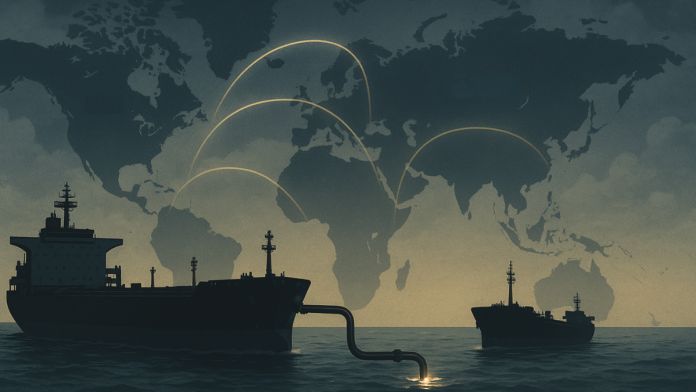New evidence has revealed a shadowy system of oil trade linking Iran, Russia, and China. Networks of brokers, shipowners, and offshore companies have built a pathway that allows sanctioned oil to reach Chinese buyers.
The process begins with tankers registered in Panama, Hong Kong, or the Marshall Islands. These ships are placed under “naval mortgages”, a special kind of legal arrangement. Instead of being used as security for loans, these mortgages act as guarantees for oil trades. If a Chinese buyer fails to pay for the cargo, the broker can claim ownership of the ship.
Documents show that more than 30 tankers, worth nearly $1 billion, were mortgaged between 2019 and 2023. Many of these vessels were later spotted carrying crude from Iran, Venezuela, and Russia. Despite official paperwork listing the cargo as “Malaysian” or “Iraqi” oil, tracking data revealed the ships loading shipments directly from Iranian and Russian ports.
Experts say this setup shows how global trade networks are adapting. They use offshore firms, weak oversight, and creative legal tools to move oil despite sanctions.
Russia crypto platforms Garantex and Grinex hit by U.S. sanctions, $27 million frozen
China’s Role in Sanctioned Oil Flows
China is the world’s largest oil importer. Its demand is enormous, and much of it is supplied by Iran and Russia. Analysts estimate that China imported around 1.5 million barrels of oil per day from Iran and about 2 million barrels per day from Russia last year.
Most of this oil is delivered to independent refineries inside China, often called “teapot refineries”. These smaller facilities are less visible than big state-owned oil companies and are more willing to handle shipments from unusual sources.
Investigations show that each oil tanker carrying sanctioned crude was registered under different companies. Many of these companies had Chinese directors with little public profile. In several cases, the listed directors seemed unaware that they “owned” multimillion-dollar ships.
India-China relations see cautious reset as US tariffs tensions escalate
At least eight companies tied to these tankers shared the same Chinese phone number. Records linked that number to individuals already sanctioned by the United States for moving Iranian oil in 2019. This suggests the same network that once moved Iran’s crude is now helping Russia.
Ship tracking data further confirms this. In February 2023, for example, the tanker Skadi loaded Russian Urals crude from the port of Primorsk. It then transferred part of the cargo at sea to another ship, An Shun II, which later delivered the oil to China.
Sanctions, Front Companies, and a Growing “Dark Fleet”
The United States and the European Union have imposed sanctions on Iranian and Russian oil. These measures restrict banks, insurers, and shipping companies from doing business with sanctioned entities. But as the new evidence shows, networks of intermediaries have found ways around the rules.
Front companies in Panama, the British Virgin Islands, Hong Kong, and other offshore hubs act as owners of record. The real buyers and sellers often remain hidden. Brokers like Panama-registered Ocean Glory Giant have been at the center of these transactions. Ocean Glory has been accused of serving as a “super-broker”, helping sanctioned oil from Iran, Russia, and Venezuela flow east.
💰 Tokyo and London break records as China retreats in $9 trillion U.S. Treasury race
Ship-to-ship transfers at sea make the cargo even harder to trace. Vessels often turn off their transponders, a practice called “going dark”, to conceal their movements. Once the oil reaches China, it enters the country’s refining system and becomes nearly impossible to track back to its source.
Analysts estimate that while these mortgages were in place, the mortgaged ships transported at least 130 million barrels of oil. The cargo was worth around $9.6 billion. About half came from Iran, a quarter from Russia, and most of it ended up in China.
The Chinese government has defended its imports, saying it opposes “illegal unilateral sanctions” and supports normal trade with countries like Iran. Officials in Beijing argue that such trade is legal under international law, even if restricted by the United States or the EU.
At least 20 of the ships used in these operations have since been placed on U.S. sanctions lists. Some of them continue to operate, despite being linked to sanctioned networks.
What these findings show is a detailed picture of how global oil trade adapts when restrictions are imposed. Iran’s decades of experience in bypassing sanctions have now been combined with Russia’s new needs, and China has emerged as the key buyer at the end of this chain.


